आलू में बीज आकार को अधिकतम करने के लिए तकनीकी हस्तक्षेप
Good quality seed is almost universally considered a requirement for high productivity in all potato production systems. Much of the yield gap currently constraining productivity is attributed to the poor quality of seed. Potato seed sector development is thus a major concern of governments, researchers, development agencies, and civil society organizations. Seed is the most important part of the production cycle of many crops, including potatoes.
Seed determines important factors such as yield, quality and overall crop health. Starting with good- quality seed is the first step to a successful crop year. Selecting and planting clean, disease-free potato seed tuber is the first step to assure a successful potato crop. Seed quality has a direct bearing on the potato productivity. Seed multiplication rate in potato is only 1 : 6 and production cost is very high due to stringent quality control.
Seed production is very technical aspect and needs careful attention during its cultural operations viz date of planting, spacing, fertilization, top-dressing, irrigation, roguing, weeding, earthing up, spraying of pesticides, date of dehaulming, harvesting, etc. Quality of seed potato is important for good yield therefore seed production; storage should be carefully carried out.
In India, seed cost accounts from 40 to 50%. The situation is further aggravated in high bulking cultivars which has tendency to produce more numbers of oversize tubers. Seed cost actually depends on seed size and intra-row spacing. Seed tuber is the single most important factor in potato cultivation and if the seed does not possess good qualities, then optimum production could not be achieved. Potato yields are affected by several factors. Quality seed is a very important factor. The average yield increase from the use of good quality seed is 30 to 50 percent.
Significance of seed size tubers in potato
Appropriate seed tuber size has very important implication on potato production. Seed size influences the seed rate per hectare. The number of sprouts that develop from a seed tuber is influenced by the size of seed tuber. In larger tubers, growth is faster because of greater food reserve availability for each sprout and generally produce more sprouts which may result in the production of too many stems and eventually produce too many tubers.
If larger seed is used, a greater quantity of seed is required for planting per unit area. It is avoided because it increases seed costs and reduce planter’s accuracy. Conversely, smaller seed size tubers have less sprouts per unit due to the lesser amount of reserves available for sprout growth leading to small number of stems that produce only a few tubers, thereby reducing yield.
Big size seed will increase cost and seed that are too small may rot before emergence. Cut tubers may be deteriorated by bacteria and have less food reserve for the emerged plants which results to poor growth performance and lower yield.
The plantable tuber size for potato production is 40–50g for gaining maximum production potential from field. Small and medium size seed tubers are preferred by farmers engaged in small scale cultivation to reduce seed cost. For normal production, a reasonable size of seed tuber or tuber pieces should be about 40 to 50 grams.
Many factors determine tuber size distribution such as number of stems per plant and the rate of crop growth which are difficult to manipulate. One of the most controllable factors is seed size. Low variation of tuber size is desirable in seed production.
Agro-techniques for enhancing seed size tuber
Obtaining seed size tuber is important for achieving higher potential of the cultivars. The tuber size profile can be reduced or expanded by altering inter and intra row seed spacing, controlling days of growth by planting late or killing vines/haulm early, regulating inputs like fertilizer and water, applying growth regulators, and manipulating seed tuber physiological age.
When potatoes are grown for seed, cultural practices need to be used in order to maximize the proportion of seed size tubers and decrease the yield of large tubers. In practice, the space between the potato plants is manipulated by the number and size of the tubers planted which increased total yield, but decreased the percentage of large potato tubers that will be produced.
The possibility of ensuring a high yield largely depends on the maintenance of an optimal number of plants per unit area and their spatial arrangement in the field. In the present paper different aspects and techniques of production of potato seed size is discussed.
Planting geometry/ density
Planting geometry influenced yield, tuber size distribution, number, stem density and net returns of potato cultivars. Optimizing of plant density is one of the most important agronomic practices of potato production, because it directs seed cost, plant development, yield and quality of the crop. One way to adjust the size of tubers is to manipulate plant density.
Increasing the planting density may lead to a decrease in the average weight of the tuber and the percentage of the large size tubers. An ideal combination of plant population, row width, and in-row seed spacing for a particular variety were the major factors for optimizing tuber size and increasing grower’s revenue. Planting of seed tubers on ridges is widely followed method with some modifications from place to place.
As against single-row geometry of planting on each ridge, paired-row planting on ridges at different spacing has also been tested keeping constant or variable seed rates. Seed size tubers (25–125 g) are very important for use as seed tubers in the successive crop season.
Significantly higher seed size tuber number (405 thousand/ha, 56.56%) and weight (22.44 t/ha, 67.67%) was recorded with closer intra row spacing of 60×15 cm and with flatbed of 90 cm width with two rows of 20 cm plant to plant spacing 487 thousand/ha tuber number and weight (29.52 t/ha) in Kufri Khyati under Gwalior conditions of India.
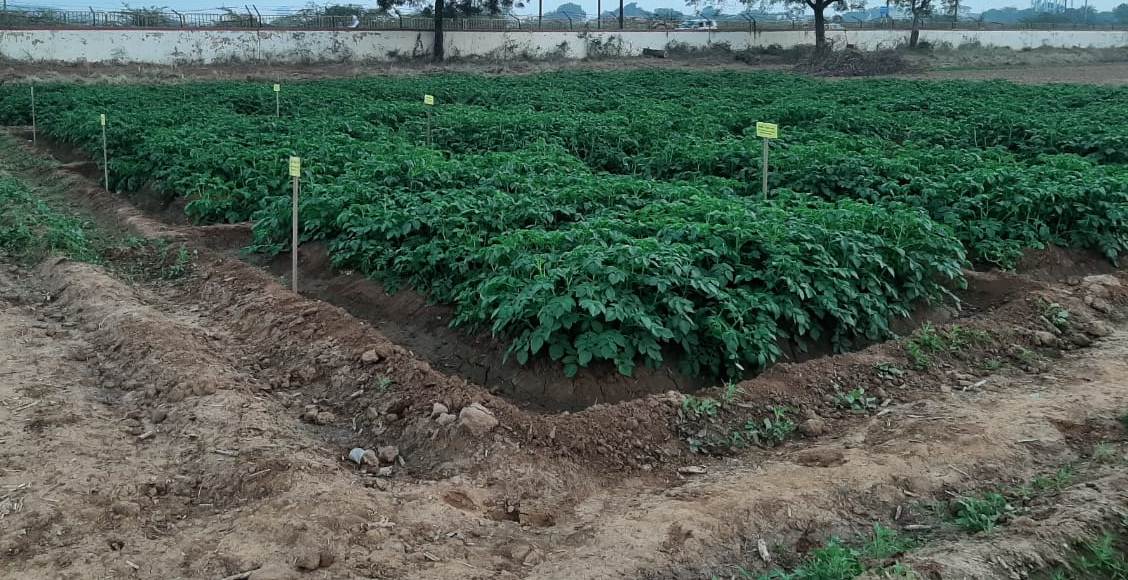
Fig1 Field view of different spacing combinations
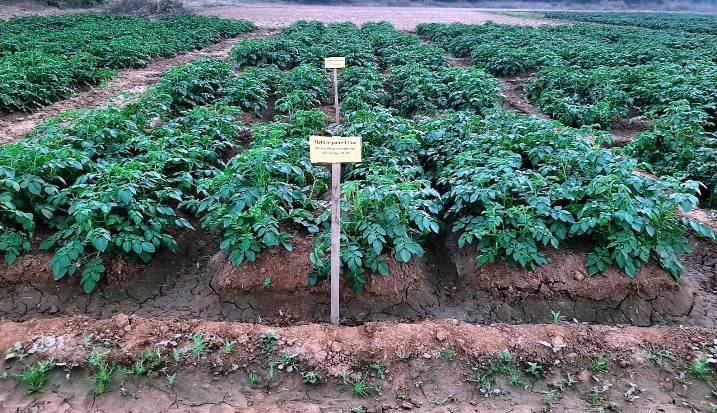
Fig 2 Field view of paired row spacing combinations
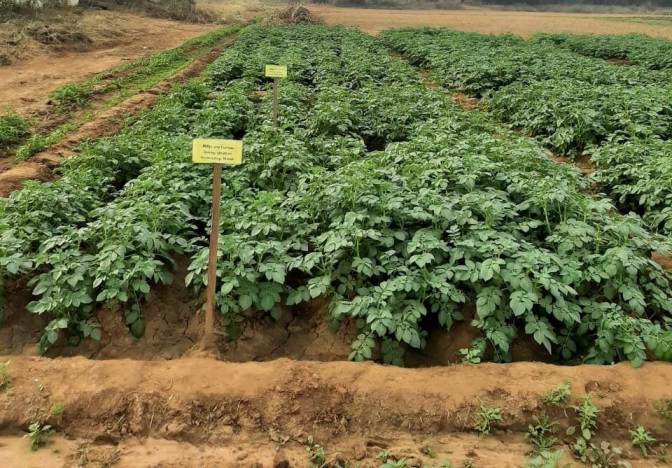
Fig 3 Field view of 60×20 cm spacing combinations
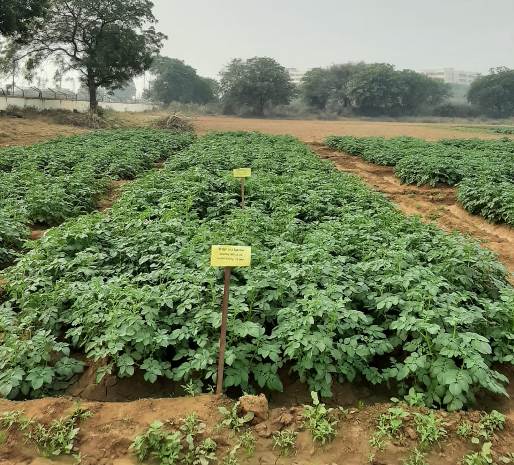
Fig 4 Field view of 60×15cm spacing combinations
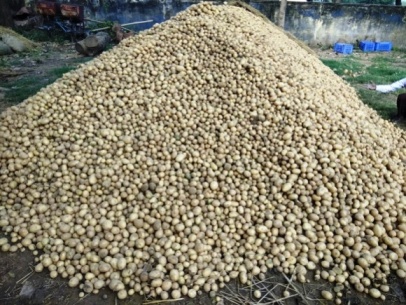
Fig 5 Heap of seed size tubers
Genotypes / varieties
The genotype determines tuber number, tuber size and yield potential for any given cultivar. Varietal difference may occur for seed size tuber production as the cultivars vary in maturity and their bulking capacity. Cultivar can influence whether size or weight of tubers will affect yield of progeny tubers.
Average yield of seed size tubers (25-125g) in Kufri Jyoti (217 thousand/ha and 48.30%), Kufri Gaurav (288 thousand/ha and 44.60%), Kufri Lauvkar (185 thousand/ha and 49.39%) in three haulm killing dates and in Kufri Khyati (338 thousand/ha) in two haulm killing dates and Kufri Lauvkar (223 thousand /ha and 56.66%), Kufri Chandramukhi (232 thousand/ha and 56.62%), Kufri Chipsona-1 (325 thousand /ha and 62.28%) and Kufri Sindhuri (399 thousand /ha and 47.71%) in one haulm killing at 80 days after planting under Gwalior conditions of Madhya Pradesh, India. This indicates the variation in tuber bulking ability in different genotypes resulting in variation in proportion of seed size tubers among different varieties.
Fertilizer combinations
Apart from the choice of cultivar, plant protection and continuous water supply, a further important agronomic measure for potato production is adequate nutrient management. Nitrogen (N), phosphorous (P) and potassium (K) are the nutrients which are most commonly applied in potato production. Proper management of N, P, and K fertilizers is considered very important to maximize tuber yield and attain desirable quality.
Increasing N supply can increase the proportion of large-sized tubers which is unfavorable for seed production. Potato yield can be divided into the three components: ‘number of stems per square meter’, ‘number of tubers per stem’ and ‘average tuber weight’, whereby N has the greatest impact on the average tuber weight.
P has a significant impact on the setting of potato tubers, especially in the early growth states but also at later growth stages where P enhances tuber maturity. A sufficient supply of K is also needed for high biomass production and leaf area development.
Fertilizer combination of 120 : 60 : 100 Kg/ha NPK yielded highest seed size tuber number (373 thousand /ha) and found to be economical combinations in seed production system of high bulking cultivar Kufri Khyati under Gwalior condition of Madhya Pradesh.
Haulm/ vine killing
Haulm/ vine killing is one of the criteria used in seed potato production primarily to regulate tuber size profile. Haulm killing is done to stop tuber growth in order to optimize seed size and to obtain a uniform size distribution with a maximum proportion of the tubers in the most profitable size class. Vine killing is also done to reduce the risk of spread of viral infection by inhibiting plant-to-plant spread through vectors such as aphids.
Where the growing season is short, haulm killing can be used to advance harvesting, obtain a suitable tuber size, strengthen tuber skins before harvesting, and prevent plant pathogens from spreading among the foliage and crop.
Haulm killing method is used for controlling tuber size, is easy to implement. Haulm pulling to cut off the tubers from the roots was found to be most effective.
Haulm killing for 70 days recorded higher seed size (25-125g) tuber per cent (55.40 and 68.12) in two spacing study, (48.16 and 65.12 ) and (51.55 and 68.12) in two different study of five spacing’s by number and weight respectively in Kufri Khyati under Gwalior conditions of India.
Conclusion
Size of the seed potato tuber plays important role in augmenting the production potential of potato cultivar. Narrow planting geometry (60 ×15 cm2) or flatbed 90 cm bed width (two rows 20 cm plant to plant spacing) with haulm killing after 70 days and NPK dose (120–60:100 kg/ha) resulted in increased seed size tuber number and weight in seed potato production system with variation in cultivars in their bulking ability
References
- Sharma, S., Dudi, B.S., Khurana S.C. 2001. Effect of cut and whole seed tubers for planting during autumn at Hissar. Journal of Indian Potato Association 28: 64-65.
- Sadawarti, M.J. , Bhatnagar A., Singh S.P., Pandey K.K.,2014. Prospect of Early Planting of Potato Seed Crop in Central India. Indian Journal of Hill Farming 27(1):12-16.
- Sadawarti, M., Singh, R. K., Samadhiya, R. K., Singh, S. P., Pandey, K. K., Roy, S. Chakrabarti S. K., 2017. Maximization of seed size tuber production in early bulking potato (Solanum tuberosum) variety Kufri Khyati. International Journal of Bio-resource and Stress Management 8(6): 753-757.
- Sadawarti, M. J., Singh, R. K., Samadhiya, R. K., Singh, S. P., Roy, S., Singh, V., Rawal, S., Buckseth, T., Kumar, R.,Chakrabarti, S. K., 2019. Revisiting of planting dates for maximizing seed size potato (Solanum tuberosum L) tuber yield as per changing climatic scenario. Indian Journal of Agricultural Sciences 89 (4), 646–652.
- Sadawarti, M. J., Singh, R. K., Singh, S. P., Samadhiya, R. K. and Katare, S.,Kumar, R.,Rawal, S.,Singh, V., Optimization of planting geometry and haulm killing days for increasing production of seed size tubers in potato. Indian Journal of Agricultural Sciences (submitted).
- Sadawarti M J, Singh R. K., Singh S. P., Samadhiya, R. K.,Katare S., 2021b. Effect of haulm killing date and variety on production of seed size tubers in potato Indian Journal of Agricultural Sciences (submitted).
Authors:
Murlidhar Sadawarti, Shiv Pratap Singh, Rajesh Kumar Singh, Subhash Katare, Rajendra Kumar Samadhiya and Tanuja Buckseth
ICAR–Central Potato Research Institute, RS Gwalior, Madhya Pradesh 474020
ICAR–Central Potato Research Institute, Shimla, Himachal Pradesh 171001
Email:
